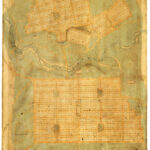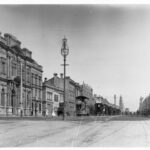The city of Adelaide refers here to the area within the outer boundary of the parklands; that is, the ‘square mile’ of the commercial centre, plus North Adelaide, the city’s first suburb.
The city was founded on the last day of 1836, when the surveyor-general of the incipient colony, William Light, fixed its location about 12 kilometres inland on the eastern shore of Gulf St Vincent. The site was ‘on the bank of a beautiful stream, with thousands of acres of the richest land I ever saw’, according to Governor John Hindmarsh. Critics like the rancorous journalist George Stevenson had less flattering descriptions (‘cucumber beds half a day’s journey inland’), but Light’s choice was vindicated within a few years of his early death in 1839.
Light’s Plan
Light surveyed the site between January and March 1837. No doubt taking his cue from the layout of most New World cities established on greenfield sites early in the nineteenth century, Light used a grid-iron plan which derives ultimately from the Roman castrum. The main part was on gently sloping ground, but where necessary, as in North Adelaide and in East Terrace, he shifted the orientation of the streets to follow the contours. The survey finished, the 1042 town acres were distributed to their purchasers (most land having been sold well before the settlers took ship) with the order of choice determined by lot.
Adelaide’s most distinctive feature is the band of parklands that surrounds and bisects the two parts of the city and which now rules it off neatly from the sprawling suburbs beyond. How Light decided on this concept, or even whether he was responsible for it at all, has been a matter for speculation. Similar arrangements may be observed in other planned cities of the same era, Portland, Oregon, United States, with its ‘park blocks’ being the most comparable example. Except for the sections designated government reserves, in the 1840s all the parklands were placed under the ‘care, control and maintenance’ of the City Council. Thanks to its stewardship – the council has doggedly fought off many attempts at expropriation – the parklands have remained fairly intact.
Development
Adelaide developed as a virtual city-state, dominating its vast thinly populated hinterland to a degree unique in Australia. Not only was it the sole commercial centre of its region, but for half of the twentieth century it was also the sole industrial centre. The fortunes of the city therefore mirrored the boom-and-bust economy of South Australia. In the booms, such as the one following the discovery of copper in the Mid North in 1860, wealth poured into the city, lavishly endowing the university and the cultural resources on North Terrace and financing the construction of grand mansions. During the busts, as in the 1890s and 1930s, when up to a third of male workers were unemployed, the ramshackle encampments by the River Torrens at Pinkie Flat expanded and the semi-slums around Light Square became ever more derelict.
Development in the first century of white settlement was limited mostly to the infilling of the vacant town acres and, particularly in the west end and North Adelaide, their sub-division by small cross-streets and lanes lined with terraced cottages. Except in the small commercial core, the city was still a place where people lived, even though its share of the metropolitan population fell steadily. (Fifty years after settlement 40 per cent of urban residents were living within the parklands; but after another 50 years only 12 per cent were still doing so.) Amenities improved enormously: the city was deep-sewered in 1880–83, helping to curb the appalling infant mortality rate which was then the worst in the country; the Torrens was dammed to produce an ornamental lake in 1881; Light’s generously wide streets required few adjustments to accommodate motor vehicles from 1900; and all the central roads were sealed with bitumen in the 1920s.
Population Change and Changing Land-Use
The most drastic transformation over the next 60 years was the flight of residents to the suburbs and therefore radical changes in the city’s land use. The population had peaked at 43 164 in 1920, remaining fairly stable at about 39 000 until the end of World War II. But in the 1950s virtually all the square mile became a de facto industrial zone. Warehouses, business premises, workshops and waste ground used for car parking replaced houses in many of the cross-streets. For at least a decade after 1957 the city lost 175 dwellings and 900 people each year. Indeed, a planning report of 1962 foresaw, and welcomed, no dwellings at all in the South Adelaide of 30 years hence. Adelaide was en route to becoming a ‘doughnut’ city, occupied only by the poor and the childless affluent.
Fortunately the dangers were recognised in time. The city planner, Hugh Bubb, saw at first hand in America the social consequences of eviscerating inner cities. However, the proposed remedies would have been much worse than the disease. One scheme called for the virtual levelling of the south-east corner, except for St John’s Church, and its total reconstruction in the form of massive apartment blocks on the model of La Défense in Paris. Fortunately such grandiose plans foundered on the usual rock – lack of money. More modest initiatives, such as the first City of Adelaide Plan in 1974, as well as solid incentives to private developers to refurbish semi-derelict sites and buildings, made recovery of the residential population to at least half the level of the 1920s a practicable goal for the early twenty-first century.
Continuously Changing Cityscape
In the competing claims for conservation versus development, Adelaide has suffered some grievous losses. The demolition of the Exhibition Building and the South Australian Hotel on North Terrace, the Theatre Royal in Hindley Street, and the Grand Central Hotel on the Rundle/Pulteney Street corner are only the leading items on a long roll of infamy. Adelaide is still suffering the legacy of what seems to have been, in retrospect, a nadir in the arts of public architecture and civic design in the 1960s and early 1970s: the transformation of some of the parklands into themed ‘gardens’, the visual obliteration of Victoria Square by diagonal roads unsympathetic to Light’s angular forms, and too many ugly curtain-wall blocks such as the Schulz Building on Kintore Avenue. But the city has generally fared at least as well as other Australian capital cities, and there were some victories for preservation. The 1980s and 1990s also produced some imaginative and inspiring buildings: Rod Roach’s fire station in Wakefield Street, Guy Maron’s Bicentenary Conservatory in the Botanic Gardens, and some of the office conversions of the 1980s boom.
Light’s city has remained remarkably true to its founder’s vision. Admittedly, it has not evolved quite as he planned. Two inherent weaknesses soon became evident: the inadequate provision of north–south cross routes, and the lack of provision for a railway, which led to the alienation of a huge swathe (more than 50 hectares) of prime parklands. Nor did Victoria Square ever become the city’s heart. But William Light’s ghost would have no difficulty recognising the city 160 years after he made his first sketch of the ‘town Adelaide’ in February 1837.






Comments